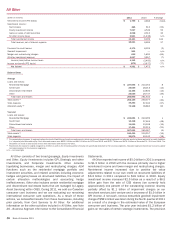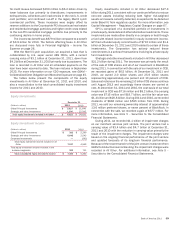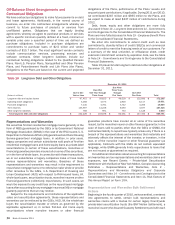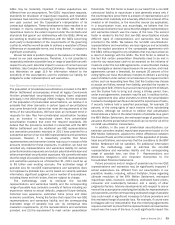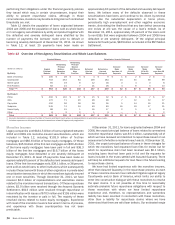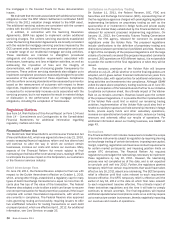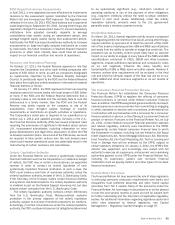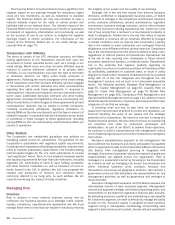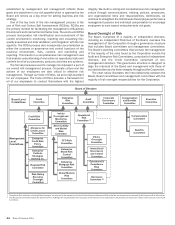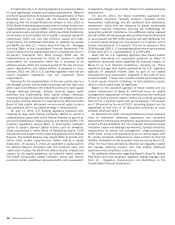Bank of America 2011 Annual Report Download - page 60
Download and view the complete annual report
Please find page 60 of the 2011 Bank of America annual report below. You can navigate through the pages in the report by either clicking on the pages listed below, or by using the keyword search tool below to find specific information within the annual report.58 Bank of America 2011
has been much slower than in non-judicial states. The pace of
foreclosure sales in judicial states increased significantly by the
fourth quarter of 2011. However, there continues to be a backlog
of foreclosure inventory in judicial states. The implementation of
changes in procedures and controls, including loss mitigation
procedures related to our ability to recover on FHA-insurance
related claims, and governmental, regulatory and judicial actions,
may result in continuing delays in foreclosure proceedings and
foreclosure sales, and create obstacles to the collection of certain
fees and expenses, in both judicial and non-judicial foreclosures.
We entered into a consent order with the Federal Reserve and
BANA entered into a consent order with the OCC on April 13, 2011.
These consent orders require servicers to make several
enhancements to their servicing operations, including
implementation of a single point of contact model for borrowers
throughout the loss mitigation and foreclosure processes,
adoption of measures designed to ensure that foreclosure activity
is halted once a borrower has been approved for a modification
unless the borrower fails to make payments under the modified
loan and implementation of enhanced controls over third-party
vendors that provide default servicing support services. In
addition, the OCC consent order required that we retain an
independent consultant, approved by the OCC, to conduct a review
of all foreclosure actions pending, or foreclosure sales that
occurred, between January 1, 2009 and December 31, 2010 and
submit a plan to the OCC to remediate all financial injury to
borrowers caused by any deficiencies identified through the review.
The review is comprised of two parts: a sample file review
conducted by the independent consultant, which began in October
2011, and file reviews by the independent consultant based upon
requests for review from customers with in-scope foreclosures.
We began outreach to those customers in November 2011, and
additional outreach efforts are underway. Because the review
process is available to a large number of potentially eligible
borrowers and involves an examination of many details and
documents, each review could take several months to complete.
We cannot yet accurately determine how many borrowers will
ultimately request a review, how many borrowers will meet the
eligibility requirements or how much in compensation might
ultimately be paid to eligible borrowers.
We continue to be subject to additional borrower and non-
borrower litigation and governmental and regulatory scrutiny
related to our past and current servicing and foreclosure activities,
including those claims not covered by the Servicing Resolution
Agreements, defined below. This scrutiny may extend beyond our
pending foreclosure matters to issues arising out of alleged
irregularities with respect to previously completed foreclosure
activities. The current environment of heightened regulatory
scrutiny may subject us to inquiries or investigations that could
significantly adversely affect our reputation and result in material
costs to us.
Servicing Resolution Agreements
On February 9, 2012, we reached agreements in principle
(collectively, the Servicing Resolution Agreements) with (1) the
DOJ, various federal regulatory agencies and 49 state attorneys
general to resolve federal and state investigations into certain
origination, servicing and foreclosure practices (the Global AIP),
(2) the Federal Housing Administration (the FHA) to resolve certain
claims relating to the origination of FHA-insured mortgage loans,
primarily by Countrywide prior to and for a period following our
acquisition of that lender (the FHA AIP) and (3) each of the Federal
Reserve and the OCC regarding civil monetary penalties related
to conduct that was the subject of consent orders entered into
with the banking regulators in April 2011 (the Consent Order AIPs).
The Servicing Resolution Agreements are subject to ongoing
discussions among the parties and completion and execution of
definitive documentation, as well as required regulatory and court
approvals. There can be no assurance as to when or whether
binding settlement agreements will be reached, that they will be
on terms consistent with the Servicing Resolution Agreements, or
as to when or whether the necessary approvals will be obtained
and the settlements will be finalized.
The Global AIP calls for the establishment of certain uniform
servicing standards, upfront cash payments of approximately $1.9
billion to the state and federal governments and for borrower
restitution, approximately $7.6 billion in borrower assistance in
the form of, among other things, principal reduction, short sales,
deeds-in-lieu of foreclosure, and approximately $1.0 billion in
refinancing assistance. We could be required to make additional
payments if we fail to meet our borrower assistance and refinancing
assistance commitments over a three-year period. In addition, we
could be required to pay an additional $350 million if we fail to
meet certain first-lien principal reduction thresholds over a three-
year period. We also entered into agreements with several states
under which we committed to perform certain minimum levels of
principal reduction and related activities within those states as
part of the Global AIP, and under which we could be required to
make additional payments if we fail to meet such minimum levels.
The FHA AIP provides for an upfront cash payment of $500
million and the FHA would release us from all claims arising from
loans originated on or before April 30, 2009 that were submitted
for FHA insurance claim payments prior to January 1, 2012, and
from multiple damages and penalties for loans that were originated
on or before April 30, 2009, but had not been submitted for FHA
insurance claim payment. An additional $500 million would be
payable if we fail to meet certain principal reduction thresholds
over a three-year period.
Pursuant to an agreement in principle, the OCC agreed to hold
in abeyance the imposition of a civil monetary penalty of $164
million. Pursuant to a separate agreement in principle, the Federal
Reserve will assess a civil monetary penalty in the amount of $176
million against us. Satisfying our payment, borrower assistance
and remediation obligations under the Global AIP will satisfy any
civil monetary penalty obligations arising under these agreements
in principle. If, however, we do not make certain required payments
or undertake certain required actions under the Global AIP, the OCC
will assess, and the Federal Reserve will require us to pay, the
difference between the aggregate value of the payments and
actions under these agreements in principle and the penalty
amounts.
Under the terms of the Global AIP, the federal and participating
state governments would release us from further liability for certain
alleged residential mortgage origination, servicing and foreclosure
deficiencies. In settling origination issues related to FHA
guaranteed loans originated on or before April 30, 2009, the FHA
would provide us and our affiliates a release for all claims with
respect to such loans if an insurance claim had been submitted
to the FHA prior to January 1, 2012 and a release of multiple
damages and penalties (but not single damages) if no such claim
had been submitted.
The financial impact of the Servicing Resolution Agreements
is not expected to require any additional reserves over existing
accruals as of December 31, 2011, based on our understanding


